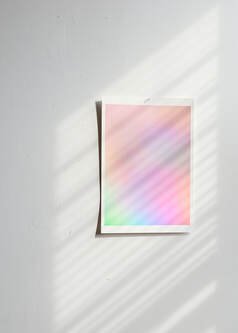Archived post, original publish date: April 11, 2020
This was the image I saw on my instagram feed that made me want to read about Stephanie Taiber's work. It's so simple, looking like a snapshot a printmaker would take of their studio. But I was grabbed by this image, pulled into this portal of pigment pinned against a stark wall. The shadow from the blinds alludes to the passing of time as do most rays of light and give this image a fleeting quality. Taiber leans into this by having another image of the same scene but the light has shifted. I prefer this single image more than the diptych. This was an image that felt relatable and lead me to discover more about Taiber.
I loved the phrasing Taiber used "the problematic nature of photography as a means of documenting both time and memory." This has been one of my biggest struggles in my current project. I want to put so much trust into photography to tell me something, reveal something, or validate something, but it always falls short. A lot can be hidden in a photograph, I see so much behind family photos of my mother that could not possibly be shown in the photograph. And I can't come up with a visual method of explaining that hidden message, being forced to resort to text in order to explain everything that I see in an image. A photograph holds truth, it can capture likeness extremely accurately, but I think the frustration and the problematic nature of photography comes from believing in truth as a purely physical. Time and memory make up so much of our understanding of the truth but we have no way of showing it.
Taiber treats the family photograph like the object it is instead of the image it represents. I find this makes her still life images engaging. The treatment of the objects obviously provides context for how we are expected to interpret the objects but it also feels like a reflection of Taiber's feelings towards the objects. Often you only get a glimpse at the original image, this does two things: makes it so that anyone can relate to the image, and allows Taiber to keep some of the original intention of the image. I struggle with the family archive in my work because it can tell such a great story but also feels incredibly vulnerable to share. These images represent my family history and is that something I want to broadcast to potentially everyone? I see my family history in Taiber's work because these images can become anyone.



